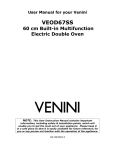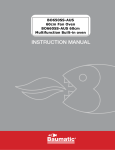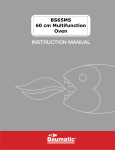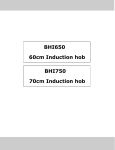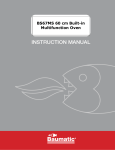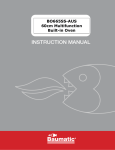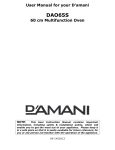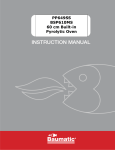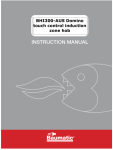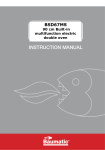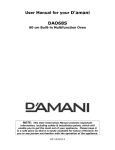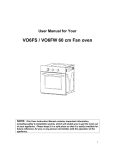Download User Manual for your - Masters Home Improvement
Transcript
User Manual for your PROSSIMO 60 cm Fan Forced Oven (HO6FS) & 60 cm Ceramic Hob. (GECE6002) NOTE: This User Instruction Manual contains important information, including safety & installation points, which will enable you to get the most out of your appliance. Please keep it in a safe place so that it is easily available for future reference; for you or any person not familiar with the operation of the appliance. JW 04/04/13 2 Contents Oven user manual Hob user manual 3 -23 24-44 Environmental note 4 Important safety information 5-7 Specifications Product and aperture dimensions Product specifications Standard accessories Electrical details Cooling fan Control panel 8 - 10 8 8 8 9 9 10 Using the oven Selecting manual operation mode Setting the auto-off timer 10-11 10 11 Selecting a cooking function and temperature Before first use Selecting an oven function Oven functions Thermostat control knob Oven operating light Cooking guidelines Warnings Shelf positions 11-15 11-12 12 12 13 13 13-14 14 14-15 Cleaning and maintenance Replacing the oven bulb Removing the oven door for cleaning 15-17 16 17 Installation Electrical connection Installing the oven into the kitchen cabinet Positioning the appliance Ventilation requirements 18-20 18 19 19 20 My appliance isn’t working correctly 21–22 Cooking tables 23 Hob user manual 24-44 Contact details 48 3 Environmental note o The packaging materials that the manufacturer environmentally friendly and can be recycled. uses are o Please discard all packaging material with due regard for the environment. 4 IMPORTANT SAFETY INFORMATION Your safety is of the utmost importance to us. Please make sure that you read this instruction booklet before attempting to install or use the appliance. If you are unsure of any of the information contained in this booklet, please contact the Retailer where you purchased your unit from. General Information o This appliance is designed for domestic household use and can be built into a standard kitchen cabinet or housing unit. o IMPORTANT: The adjacent furniture or housing and all materials used in the installation must be able to withstand a minimum temperature of 85°C above the ambient temperature of the room it is located in, whilst in use. o Certain types of vinyl or laminate kitchen furniture are particularly prone to heat damage or discolouration at temperatures below the guidelines given above. o Any damage caused by the appliance being installed in contravention of this temperature limit, or by placing adjacent cabinet materials closer than 4mm to the appliance, will be the liability of the owner. o The use of this appliance for any other purpose or in any other environment without the express agreement of the manufacturer will invalidate any warranty or liability claim. o Your new appliance is guaranteed against electrical or mechanical defects, subject to certain exclusions that are noted in the Conditions Of Guarantee. The foregoing does not affect your statutory rights. o Repairs may only be carried out by authorised service agents. IMPORTANT: Warranty must be registered as two separate products. 5 Warning and safety instructions o This appliance complies with all current Australian safety legislation. We do wish to emphasise that this compliance does not remove the fact that the appliance surfaces will become hot during use and retain heat after operation. o This appliance is not intended for use by persons (including children) with reduced physical, sensory or mental capabilities, or lack of experience and knowledge, unless they have been given supervision or instruction concerning use of the appliance by a person responsible for their safety. Child Safety o We strongly recommend that babies and young children are prevented from being near to the appliance and not allowed to touch the appliance at any time. o If it is necessary for younger family members to be in the kitchen, please ensure that they are kept under close supervision at all times. o Children should be supervised to ensure that they do not play with the appliance. General Safety o Do not place heavy objects on the oven door or lean on the oven door when it is open, as this can cause damage to the oven door hinges. o Do not leave heated oil or fat unattended, as this is a fire risk. o Do not place pans or baking trays directly on the base of the oven cavity, or line it with aluminium foil. o Do not allow electrical fittings or cables to come into contact with areas on the appliance that get hot. o Do not use the appliance to heat the room it is located in or to dry clothing. o Do not install the appliance next to curtains or soft furnishings. o Do not attempt to lift or move cooking appliances by using the oven door or handle, as this may cause damage to the appliance or result in injury to the person lifting the appliance. 6 Cleaning o Cleaning of the oven should be carried out on a regular basis. o Great care should be taken whilst using this appliance and when following the cleaning procedure. o IMPORTANT: The appliance must be disconnected from the mains before following the cleaning procedure. Installation This appliance must be correctly installed by a suitably qualified person, strictly in accordance with the manufacturer’s instructions. o The manufacturer declines any responsibility for injury or damage, to person or property, as a result of improper use or installation of this appliance. o Heat, steam and moisture will be created during use of the appliance, take care to avoid injury and ensure that the room is adequately ventilated. If the appliance is going to be used for prolonged periods of time, then additional ventilation may be required. o Please consult with your qualified installer if you are in any doubt about the amount of ventilation that you will require. 7 Specifications Product Dimensions Aperture Dimensions Height: Width: Depth: 595 mm 603 mm 565 mm (min) 590 mm 595 mm 550 mm Product specifications o o o o o o o 4 oven functions Energy efficiency class: A Oven net/gross capacity: 50/59 litres Cooling fan Double-glazed removable door Removable inner door glass Oven light Standard accessories o Safety shelf o Enamelled baking tray o Trivet 8 Electrical details Rated Voltage: Supply Connection: Max Rated Inputs: Mains Supply Lead: Oven Light Bulb: 220-240 Vac 50 Hz 15A GPO 2.35 kW 3 x 1.5mm² 25 W/300°C screw type pygmy Cooling fan o A tangential cooling fan is fitted inside of this appliance, to make the internal temperature of the oven stable and the external surface temperature lower. o After you have finished cooking and switched off the oven, the cooling fan will continue to run for a period of time afterwards. The length of time will depend on how long the oven has been switched on for and at how high a temperature. For future reference please record the following information which can be found on the rating plate and the date of purchase which can be found on your sales invoice. The rating plate for your oven can be located by opening the oven door and looking around the outer edge of the oven chassis. Model Number ………………………………. Serial Number ………………………………. Date of Purchase ………………………………. 9 Control Panel 1) 2) 3) 4) 5) Oven function selector knob Auto-off timer / manual operation control knob Thermostat control knob Power indicator light Oven operating light Using the oven Selecting manual operation mode Before you can select a cooking function or set a temperature, you must set the appliance into manual operation mode. o Turn the manual operation control knob (3) anti-clockwise, so that it points at the word ON. 10 Selecting a cooking function and temperature IMPORTANT: Make sure that you have selected your oven into manual operation mode before selecting an oven function and temperature. Before first use o To remove any residue from the oven that from the manufacturing process, you conventional oven function and set the maximum temperature setting. may have been left should select the thermostat to its o It is perfectly normal for a smell to be produced during this process. o You should make sure that any windows in the room are left open during this process. o It is advisable for you not to remain in the room whilst the burning off process is taking place. o You should leave the oven on maximum setting for 30 – 40 minutes. o After the oven cavity has cooled, it should then be cleaned with warm soapy water, using either a sponge or soft cloth. No abrasive cleaners should be used. o Outer parts of the oven should be cleaned with warm soapy water, using either a sponge or soft cloth. No abrasive cleaners should be used. o We would recommend that an appropriate stainless steel cleaner and polish is regularly used on the stainless steel surfaces of this appliance. 11 Selecting an oven function The oven function selector knob should be used to select the particular mode of cooking that you require. The appliance will utilise different elements within the oven cavity, depending on the oven function that you select. When a function is selected, the power indicator light will come on. Oven functions OVEN LIGHT: Separate light control which allows the light to be switched on, even when the oven is not cooking. GRILL: This method of cooking utilises the inner part only of the top element, which directs heat downwards onto the food. This function is suitable for grilling small portions of bacon, toast and meat etc. DEFROST MODE: The fan runs without heat to reduce the defrosting time of frozen foods. The time required to defrost the food will depend on the room temperature, the quantity and type of food. Always check food packaging for the defrosting instructions. FAN OVEN: This method of cooking uses the circular element while the heat is distributed by the fan. This results in a faster and more economical cooking process. The fan oven allows food to be cooked simultaneously on different shelves, preventing the transmission of smells and tastes from one dish onto another. Thermostat control knob o The oven thermostat control knob sets the required temperature of the oven. It is possible to regulate the temperature within a range of 50 - 250°C. o Turn the control knob clockwise. Oven operating light o This light will come on to indicate that the oven’s heating elements are in operation. The light will turn off when the temperature set on the thermostat control knob has been reached. It will cycle on and off throughout the cooking time. 12 You should not place food inside the cavity, until the correct cooking temperature has been reached. Cooking guidelines o Please refer to the information given on food packaging for guidance on cooking temperatures and times. Once familiar with the performance of your appliance, temperatures and times can be varied to suit personal preference. o If you are using the fan oven function, then you should follow the information given on the food packaging for this particular mode of cooking. o You should pre-heat the oven and not place food inside of it until the oven operating light has gone off. You can choose not to preheat when using the fan oven mode; however you should extend the cooking time given on the food packaging by at least ten minutes. o IMPORTANT: You should ALWAYS pre-heat the oven if you are baking. o If there is no guidance given on the food packaging specifically for cooking in fan oven mode, you can generally reduce the cooking time and temperature by 10% from the information given for conventional oven cooking. o Make sure that frozen foods are thoroughly thawed before cooking, unless the instructions on the food packaging advise that you can “cook from frozen”. o Before cooking, check that any accessories that are not required are removed from the oven. o Place cooking trays in the centre of the oven and leave gaps between the trays to allow air to circulate. o Try to open the door as little as possible to view the dishes. o The oven light will remain on during cooking. 13 Warnings o Keep the oven door closed when using ALL oven functions, including the grill function. The oven door must also be left shut whilst the oven is cooling after use. o Do not use aluminium foil to cover the enamelled baking tray or heat items wrapped in aluminium foil under the grill. The high reflectivity of the foil could potentially damage the grill element. o You should also never line the base of your oven with aluminium foil. o During cooking, never place pans or cookware directly onto the bottom of your oven. They should always be placed on the shelf provided. o The grill heating element becomes extremely hot during operation, avoid touching it inadvertently when handling the food which you are grilling. o Important: Be careful when opening the door, to avoid contact with hot parts and steam. Shelf positions Your oven will come supplied with the following oven furniture: (A) Oven shelf (B) Enamelled baking tray o The numbers 1 – 4, indicate the different shelf positions that you can utilise within the oven. o You should use the shelf position(s) that you find are best suited to your personal cooking preferences. o Insert the Oven Shelf and Baking Tray between the 2 side rails at any position (1 to 4) on both sides. The Oven Shelf has safety stops to prevent accidental withdraw. After engaging the Oven Shelf into the side rails, as you push the Oven Shelf into the oven, lift the front of the shelf slightly to bypass the stops and allow the Oven shelf to slide fully into the rails. 14 o To remove the oven shelf, gently pull the Oven Shelf outwards. When the shelf stops lift the front slightly to completely withdraw the Oven Shelf from the oven. o When installed correctly, the shelf and tray should be horizontal and not on an angle. Cleaning and maintenance Cleaning operations must only be carried out when the oven is cool. The appliance should be disconnected from your mains supply before commencing any cleaning process. o The oven should be thoroughly cleaned before it is operated for the first time and after each use. This will avoid residual food stuffs becoming baked on the oven cavity. After residues have been baked on several times, they are far more difficult to remove. o Never clean the oven surfaces by steam cleaning. o The oven cavity should only be cleaned with warm soapy water, using either a sponge or soft cloth. No abrasive cleaners should be used. o Any stains that may appear on the bottom of the oven will have originated from food splashes or spilt food, these splashes occur during the cooking process. These could possibly be a result of the food being cooked at an excessively high temperature or being placed in cookware that is too small. o You should make sure that the cooking temperature that is selected is appropriate for the food that you are cooking. You should also ensure that the food is placed in an adequately sized dish and use the enamelled baking tray where appropriate. o Outer parts of the oven should only be cleaned with warm soapy water, using either a sponge or soft cloth. No abrasive cleaners should be used. o We would recommend that an appropriate stainless steel cleaner and polish is regularly used on the stainless steel surfaces of this appliance. o If you use any form of oven cleaner on your appliance, then you must check with the manufacturer of the cleaner that it is suitable for use on your appliance. 15 o Do not use harsh or abrasive cleaners or sharp metal scrapers to clean the oven door glass since they can scratch the surface which may result in shattering. o Any damage that is caused to the appliance by a cleaning product will not be fixed by the manufacturer free of charge, even if the appliance is within the guarantee period. Replacing the oven bulb IMPORTANT: The oven must be disconnected from your mains supply before you attempt to either remove or replace the oven bulb. o Remove all oven shelves, the drip tray and the side rack that is on the same side as the oven light. o Remove the light cover by turning it anticlockwise. o Unscrew the bulb clockwise and remove it from its holder. o Replace the bulb with a 25 W/300°C, screw type pygmy. o Do not use any other type of bulb. o Place the lamp cover back into position. 16 Removing the oven door for cleaning To facilitate the cleaning of the inside of the oven and the outer frame of the oven, the door can be removed as follows:o The hinges (A) have two movable bolts on them (B). o If you raise both of the movable bolts (B), then the hinges (A) are released from the oven housing. o You should grip the sides of the door at the centre and then incline it slightly towards the oven cavity and then pull the door gently away from the oven cavity. o IMPORTANT: You should make sure that the door is supported at all times and that you place the door on some padded material whilst cleaning it. o The oven door and door glass should only be cleaned using a damp cloth and a small amount of detergent. The cloth MUST NOT have come into contact with any form of cleaning product or chemical previously. o To refit the door you should slide the hinges back into their slots and open the door fully. o IMPORTANT: The movable bolts (B) must be closed back into their original positions before closing the door. o Take care not to dislodge the hinge locking system when removing the door, as the hinge mechanism has a strong spring. o Do not immerse the door in water at any time. 17 INSTALLATION The installation must be carried out by a suitably qualified person, in accordance with the current version of the following. o AS/NZS 3000: 2007 Wiring Regulations o 2010 Electricity Safety Regulations Electrical connection Before connecting the appliance, make sure that the supply voltage marked on the rating plate corresponds with your mains supply voltage. WARNING: THIS APPLIANCE MUST BE EARTHED. o This appliance should be wired/plugged into a 15A double pole switched fused power outlet, having 3 mm contact separation and placed in an easily accessible position adjacent to the appliance. The spur outlet must still be accessible even when your oven is located in its housing. o To connect the oven power cord, loosen and remove the cover on the terminal block, in order to gain access to the contacts inside. Make the connection, securing the cord in place with the cable clamp provided and then immediately close the terminal block cover again. o If you have to change the oven power cord, the earthing (yellow/green) conductor must always be 10 mm longer than the line conductors. o Care must be taken to ensure that the temperature of the mains supply cable does not exceed 50°C. o If the supply cord is damaged, it must be replaced by the manufacturer, its service agent or similarly qualified persons in order to avoid a hazard. An appropriate replacement can be obtained from the Spare Parts Department. 18 Installing the oven into the kitchen cabinet Positioning the appliance o Ensure that the aperture that you will be fitting the oven into is of the size given in the above diagram. o The oven must be fitted into an oven housing with the ventilation cut-outs shown in the “Ventilation requirements” section on the next page. o Ensure that the rear panel of the furniture housing unit has been removed. 19 Ventilation requirements (Figure shows the ventilation and cut-out requirements for the installation of the appliance into a standard kitchen unit). (Figure shows the ventilation and cutout requirements for the installation of the appliance into a tall housing unit). o Ensure that the oven has been securely fixed into the housing unit. The fixing of the oven into the housing is made by using four screws. These should be screwed through the oven cabinet and into the housing unit. 20 My appliance isn’t working correctly o The oven isn’t coming on. * Check that you have selected a cooking function and a cooking temperature. o There appears to be no power to the oven and grill. * Check that the appliance has been connected to the electrical mains supply correctly. * Check that the mains fuses are in working order. * Check that the operating instructions for putting the appliance into manual operation mode have been followed. o The grill function works but the main oven does not. * Check that you have selected the correct cooking function. o The grill and top oven element is not working, or cuts out for long periods of time during use. * Allow the oven to cool for approximately 2 hours. Once cool, check whether the appliance is again working properly. o My food is not cooking properly * Ensure that you are selecting the correct temperature and the correct cooking function for the food that you are cooking. It may be appropriate to adjust your cooking temperature by plus or minus 10°C, to achieve the best cooking results. o My food is not cooking evenly * Check that the oven has been installed correctly and is level. * Check that the correct temperatures and shelf positions are being used. o The oven light is not working * Refer to page 16 and follow the “Replacing the oven bulb” section. 21 o I am getting condensation in my oven * Steam and condensation is a natural by product of cooking any food with high water content, such as frozen food, chicken etc. * You may get condensation in the oven cavity and forming between the oven door glasses. This is not necessarily a sign that the oven is not working correctly. * Do not leave food in the oven to cool after it has been cooked and the oven has been switched off. * Use a covered container, where practical, when cooking to reduce the amount of condensation that forms. IMPORTANT: If your appliance appears not to be operating correctly, then you should disconnect it from your mains supply and then contact the Customer Service Department. DO NOT ATTEMPT TO REPAIR THE APPLIANCE YOURSELF. Please note that if a service technician is asked to attend whilst the product is under guarantee and finds that the problem is not the result of an appliance fault, then you may be liable for the cost of the call out charge. The appliance must be accessible for the service technician to perform any necessary repair. If your appliance is installed in such a way that an engineer is concerned that damage will be caused to the appliance or your kitchen, then he will not complete a repair. This includes situations where appliances have been tiled in, sealed in with sealant, have wooden obstructions placed in front of the appliance - like plinths, or any installation other than the one specified by the manufacturer has been completed. Please refer to the conditions of guarantee that appear on the warranty card that you receive with the appliance. IMPORTANT: The manufacturer operates a policy of continuous improvement and reserves the right to adjust and modify its products without prior notification. 22 Cooking tables Fan oven Food type Weight Pre-heat time Shelf level Temperature Cooking time Beef 1kg 15 minutes 2 200° 40-50 minutes Pork 1 kg 15 minutes 2 200° 70-80 minutes Chicken 1.2 kg 15 minutes 2 200° 50-60 minutes Duck 1.5 kg 15 minutes 2 200° 50-60 minutes Steak 0.8 kg 15 minutes 2 180° 20-30 minutes Bread 0.5 kg 15 minutes 2 200° 35-45 minutes Grill Food type Weight Pre-heat time Shelf level Temperature Cooking time Steak 0.8kg 10 minutes 3 250° 20-25 minutes Pork chop 0.8 kg 10 minutes 3 250° 25-30 minutes Chicken 1.2 kg 10 minutes 3 250° 40-45 minutes Sausage 0.6 kg 10 minutes 3 250° 15-20 minutes Hamburger 0.6 kg 10 minutes 3 250° 15-20 minutes Corn 1.2 kg 10 minutes 3 250° 20-25 minutes Vegetables 0.5 kg 10 minutes 3 250° 15-20 minutes 23 User Manual for your GECE6002 60 cm 4 Radiant zone frameless ceramic hob. NOTE: This User Instruction Manual contains important information, including safety & installation points, which will enable you to get the most out of your appliance. Please keep it in a safe place so that it is easily available for future reference; for you or any person not familiar with the operation of the appliance. GS 06/04/11 24 Contents Environmental note 26 Important safety information 27 – 30 Specifications Product and aperture dimensions Product specifications Standard accessories Electrical details Ceramic hob surface layout Control panel 30 - 32 30 30 30 31 31 32 Using the ceramic hob Before first use Control knobs Switching on a cooking zone and setting a power level Residual heat indicators Hob guidelines 32 - 35 32 33 33 34 34 - 35 Cleaning and maintenance Cleaning the ceramic hob top After each use Cleaning table Using a ceramic hob scraper Using a specialist ceramic hob cleaner 35 - 37 35 - 36 36 36 36 - 37 37 Installation Positioning Unpacking the appliance Installing the appliance Electrical connection Connecting the mains supply cable Replacing the mains supply cable 37 37 38 38 40 41 42 My appliance isn’t working correctly 43 – 44 Contact details 48 - 43 - 38 – 40 - 41 - 42 25 Environmental note o The packaging materials that we use are environmentally friendly and can be recycled. o Please discard all packaging material with due regard for the environment. 26 Important safety information Your safety is of the utmost importance to us. Please make sure that you read this instruction booklet before attempting to install or use the appliance. If you are unsure of any of the information contained in this booklet, please contact your Retailer where you purchased your unit from. General Information o This appliance is designed for domestic household use and for the cooking and frying of domestic foodstuffs. o IMPORTANT: The adjacent furniture and all materials used in the installation must be able to withstand a minimum temperature of 85°C above the ambient temperature of the room it is located in, whilst in use. o Certain types of vinyl or laminate kitchen furniture are particularly prone to heat damage or discolouration at temperatures below the guidelines given above. o Any damage caused by the appliance being installed in contravention of this temperature limit, will be the liability of the owner. o Your new appliance is guaranteed against electrical or mechanical defects, subject to certain exclusions that are noted in the Conditions Of Guarantee. The foregoing does not affect your statutory rights. o The use of this appliance for any other purpose or in any other environment without the express agreement of the manufacturer will invalidate any warranty or liability claim. o You should not use this appliance to store items on or as a work surface. o No modifications manufacturer. to the appliance are permitted by the o You should not store or place flammable or highly flammable liquids/materials on top of or near the appliance. Items made from aluminium, plastic or plastic film should also be kept away from the appliance, as they may fuse to the surface. o Repairs may only be carried out by an Authorised Service Agent. 27 Child Safety o We strongly recommend that babies and young children are prevented from being near to the appliance and not allowed to touch the appliance at any time. During and after use, all surfaces will become hot. o If it is necessary for younger family members to be in the kitchen, please ensure that they are kept under close supervision at all times. o Older children should only be allowed to utilise the appliance when supervised. General Safety The appliance should only be installed and connected by a suitably qualified person. Care should be taken to ensure that the units and work surfaces that you build the appliance into, meet with the relevant standards. If you notice any scratches, splits or cracks in the ceramic glass, you should immediately switch off the appliance and disconnect it from your mains supply. Otherwise there is the risk of electric shock occurring. During use Any film or stickers that are present on the hob surface when it is delivered should be removed before use. Care should be used when utilising the appliance, otherwise there is a risk of burns being caused. o You should not allow the electrical connection cables to come into contact with the hob surface when it is hot or any hot cookware. o If fat and oil overheats, then it can ignite extremely quickly. For this reason, when cooking with fat and oil the appliance should not be left unattended. Make sure that all of the cooking zones are switched off after use. 28 Cleaning o Cleaning of the hob should be carried out on a regular basis. o IMPORTANT: Before attempting to clean the appliance, it should be disconnected from the mains and cool. o Great care should be taken whilst using this appliance and when following the cleaning procedure. o You should not use a steam jet or any other high pressure cleaning equipment to clean the appliance. Installation This appliance must be correctly installed by a suitably qualified person, strictly in accordance with the manufacturer’s instructions. Please see the specific section of this booklet that refers to installation. o The manufacturer declines any responsibility for injury or damage, to person or property, as a result of improper use or installation of this appliance. Declaration of conformity o The manufacturer declares that the hob is built using certified materials and requires the appliance to be installed in accordance with the standards currently in force. This appliance must be used by a trained person for domestic purposes only. To avoid damaging your appliance o The ceramic glass can be damaged by objects falling onto it. o The ceramic glass edge can be damaged by knocks from cookware. o Cast iron and cast aluminium cookware with damaged bases may scratch the ceramic surface if they are dragged across it. o Pans should be lifted on and off the hob surface and not dragged. o Cooking zones should not be switched on without cookware placed on it. Also the cookware should not be empty. 29 Specifications Product dimensions: Depth: Width: Height: 520 mm 590 mm 55 mm Aperture dimensions: Depth: Width: 495 mm 565 mm Product specifications: o o o o o 2 x 1.80 kW radiant zones 2 x 1.20 kW radiant zones Side control operation 4 x Individual residual heat indicators Frameless Standard accessory o Ceramic hob scraper 30 Electrical details Rated Voltage: Supply Connection: Max Rated Inputs: Mains Supply Lead: 230 Vac 50 Hz 30A (double pole switched fused outlet with 3mm contact gap) 6.00 kW 3 core x 4 mm² For future reference please record the following information which can be found on the rating plate and the date of purchase which can be found on your sales invoice. The rating plate of your hob is located on the underneath of the appliance. Therefore it is a good idea to record this information before you install your appliance. Model Number ………………………………. Serial Number ………………………………. Date of Purchase ………………………………. Ceramic hob surface layout A B C = = = 1.80 kW radiant zones 1.20 kW radiant zones Control panel 31 Control panel Using the ceramic hob Before first use IMPORTANT: You should clean the ceramic hob surface (see “Cleaning and maintenance” section). o You should switch on one cooking zone at a time, for 5 minutes at the maximum setting. This will help to eliminate any new smell that exists and evaporate any humidity that has formed on the heating elements during transit. o Do not burn off more than one zone at once. o You must place a saucepan filled half full with cold water on each zone as you burn it off. 32 Control knobs o All operations are performed by means of the 4 control knobs that can be found on the right hand side of the hob top. o The control knob should be turned anti-clockwise or clockwise to select a heating level. The dots around the outside of each control knob indicate the power level that you have set the zone to. o A marking to the top left of each control knob, indicates which cooking zone that it controls. Switching on a cooking zone and setting a power level o Turn the control knob of the cooking zone that you wish to cook on. The control knob can be turned anti-clockwise or clockwise. o The smaller dots indicate the coolest cooking zone settings and the larger dots indicate the hottest cooking zone settings. o When you have finished cooking, make sure that you turn the control knob to the OFF position. 33 Residual heat indicators o To the left of each control knob, there is a residual heat indicator for the cooking zone that it controls. o After turning a cooking zone on, when the temperature of the zone goes above 60°C the corresponding residual heat indicator neon will switch on. o After turning a hob zone off, the residual heat indicator neon will stay on. This means that the zone has not been switched off for more than 35 minutes since last use. Therefore it is more likely that the temperature of the zone is still hot enough to cause injury. o After 35 minutes, from the zone being switched off, the residual heat indicator neon will turn off. o IMPORTANT: The residual heat indicator will disappear if your mains supply is cut. o IT IS STILL POSSIBLE TO BURN YOURSELF ON A HOB ZONE, EVEN WHEN THE TEMPERATURE OF IT HAS DROPPED BELOW 60°C. Hob guidelines o The first few times the hob top is used, it may give off an acrid, burning smell. This smell will disappear completely with repeated use. o The worktop is fitted with cooking areas of different diameter and power. o The positions where the heat will radiate from are clearly marked on the hob top. The saucepans must be positioned exactly on these zones for efficient heating to occur. Pans should have the same diameter as the cooking zone that they are being used on. o You should not use saucepans with rough bases, as this can scratch the ceramic surface. o Before use, make sure that the bases of the saucepans are clean and dry. o When cold, the base of the pans should be slightly concave, as they expand when hot and lie flat on the surface of the hob. This will allow the heat to transfer more easily. 34 o The best thickness for the base of the pans is 2 – 3 mm of enamelled steel and 4 – 6 mm for stainless steel with sandwich type bases. o If these rules are not followed, then there will be a great loss of heat and energy. Heat not absorbed by the saucepan, will spread to the hob, frame and surrounding cabinets. o Preferably cover pans with a lid to permit cooking at a lower heat. o Always cook vegetables and potatoes, etc. in as little water to reduce cooking times. o Food or liquid that has high sugar content may damage the hob top if it comes into contact with the ceramic hob surface. Any spillages should be wiped up immediately, however this may not prevent the hob surface from becoming damaged. o IMPORTANT: The ceramic hob surface is tough; however it is not unbreakable and can be damaged. Especially if pointed or hard objects are allowed to fall on it with some force. o DO NOT USE THE HOB IF THE SURFACE BECOMES BROKEN OR CRACKED. YOU SHOULD CONTACT FOR AN AUTHORISED SERVICE AGENT IMMEDIATELY. Cleaning and maintenance Cleaning operations must only be carried out when the hob is cool. The appliance should be disconnected from your mains supply before commencing any cleaning process. Cleaning the ceramic hob top Any residues that are left on the hob top surface from cleaning agents will damage it. You should remove any residues with warm water mixed with a little washing up liquid. Abrasive cleaners or sharp objects will damage the hob surface; you should clean it using warm water mixed with a little washing up liquid. 35 You may find it easier to clean some deposits whilst the hob surface is still warm. However you should take care not to burn yourself if cleaning the hob surface when it is still warm. After each use o Wipe the appliance over with a damp cloth. o Dry the appliance by rubbing the surface with a clean cloth. Cleaning table What should I use to remove the deposit? Yes Remove when the appliance has cooled down? No Yes No Fat splashes No Yes Metallic discolouration Water splashes or water rings No Yes No Yes Ceramic hob scraper Ceramic hob cleaner Ceramic hob cleaner Ceramic hob cleaner Type of deposit Remove immediately? Sugar or food/liquid containing sugar Tin foil or plastic Ceramic hob scraper Using a ceramic hob scraper It is possible to purchase a ceramic hob scraper. The following guidelines should also be followed when using the ceramic hob scraper:- o The scraper should be placed on the ceramic surface at an angle. o Residues should be removed by sliding the blade carefully over the ceramic surface. 36 o The ceramic surface should be wiped with a damp cloth that has been placed in warm water mixed with a small amount of washing up liquid. o Dry the appliance by rubbing the surface with a clean cloth. Using a specialist ceramic hob cleaner o It is possible to cleaner/conditioner. purchase a specialist ceramic hob o You should follow the instructions given by the manufacturer of the specialist ceramic hob cleaner. You should ensure that it is suitable for use on your appliance. Installation The installation must be carried out by a suitably qualified person, in accordance with the current version of the following. o AS/NZS 3000:2007 wiring o 2010 Electrical safety regulation Positioning The adjacent furniture must be able to withstand a minimum temperature rise of 85°C above the ambient temperature of the room it is located in, during periods of use. This appliance is classified as Class 3 and therefore is to be built into a kitchen unit (depending on size) or 600 mm worktop that is at least 30 mm thick. The following minimum clearance distances must be observed:o 700 mm between the hob surface and the underside of any horizontal surface above it. o 50 mm clearance around the front, back and sides of the appliance, measured from the cut out. 37 o If the hob is positioned so that the right or left hand side of the appliance will be near to the edge of a kitchen unit. There must be a gap of at least 150 mm between the side of the hob and the vertical surface of any kitchen unit that is made of a combustible material. o If the vertical surface is made of a non-combustible material, then 55 mm clearance is sufficient. HOWEVER sufficient space must be allowed for saucepan handles to be turned and for saucepans to be used safely. Unpacking the appliance When unpacking the appliance please check that the following items are contained within the packaging:1 1 1 4 4 Hob Installation and instruction manual Warranty card Fixing brackets Fixing screws Installing the appliance 38 o Cut a hole in the worktop that corresponds with the drawing shown above. o IMPORTANT: You must observe the ventilation requirements shown in the drawing above. In particular the 20 mm gap underneath the hob and the 5 mm gap underneath the front edge of the worktop. o IMPORTANT: There are ventilation holes around the outside of the hob. YOU MUST ensure that these holes are not blocked by the work top, when you put the hob into position (see drawing opposite). o Carefully turn the hob upside down and place it on a cushioned mat. o Apply the sealing strip. o IMPORTANT: Do not use a silicon sealant to seal the appliance against the aperture. This will make it difficult to remove the hob from the aperture in future, particularly if it needs to be serviced. 39 o Carefully turn the hob back over and then gently lower it into the aperture hole that you have cut out. o There are holes on the base or the sides of the hob that you can fix the four brackets to. There are three holes in each one of the brackets. o You should place the bracket on the underneath of the hob, in a position that is appropriate for the aperture that you have cut out. Using the screws provided, fix the bracket to the hob. These screws MUST be securely tightened. Electrical connection This appliance must be installed by a qualified person in accordance with the latest edition of the AS/NZS3000:2007 Regulations and in compliance with the manufacturer's instructions. Before connecting the appliance, make sure that the supply voltage marked on the rating plate corresponds with your mains supply voltage. WARNING: THIS APPLIANCE MUST BE EARTHED. o This appliance must be wired into a 30A double pole switched fused outlet, having 3 mm contact separation and placed in an easily accessible position adjacent to the appliance. It should not be located above the appliance and no more than 1.25m away from it. 40 o The outlet must still be accessible even when your hob is located in its operating position. We recommend the wall above the bench / worktop. o Cable type: H05 RRF 3 core x 4 mm² Connecting the mains supply cable o The mains terminal block is located on the underside of the hob and the terminals are accessible by removing the terminal block cover by removing the cover screw. 41 o The cable connections must be in accordance with the diagram located on the bottom of the hob (see above). o You should use a good quality screwdriver to carefully, fully tighten ALL of the terminal screws. o If when the hob is first switched on, only two of the zones work, you should recheck that the terminal screws are all fully tightened. This should be done before contacting an Authorised Service Agent. o IMPORTANT: The appliance must NOT be connected to the mains supply by means of a 13A plug and socket. o The cable can be looped if necessary, but make sure that is not kinked or trapped when the hob is in position. Care must be taken to avoid the cable being in contact with hot parts of the appliance. 42 Replacing the mains supply cable If the mains supply cable is damaged, then it must be replaced by an appropriate replacement. The mains supply cable should be replaced in accordance with the following instructions: o Switch the appliance off at the socket. o Open the terminal block on the underside of the hob. o Unscrew the terminal screws fixing the cable. o Replace the cable with one of the same length and in accordance with the specification given on page 41. o The “green-yellow” earth wire must be connected to the terminal marked . It must be about 10 mm longer than the live and neutral wires. o The “blue” neutral wire must be connected to the terminal marked with letter (N) - the live wire must be connected to the terminal marked with letter (L). My appliance isn’t working correctly o The cooking zones are not functioning or will not switch on. * Check that the mains electrical supply to the appliance is correct and working. Check the mains fuse. o The residual heat indicator has not come on after I have switched a cooking zone off. * The cooking zone has only been turned on for a short period of time; therefore it did not go above 60°C. * IMPORTANT: If the cooking zone does appear to be hotter than 60°C and the residual heat indicator has not come on, you should call for an Authorised Service Agent. o A humming sound is heard when a cooking zone is selected. * This is normal; the sound will disappear when the zone heats up. 43 o The cooking zones have become discoloured. * This maybe caused by burnt on remnants of food. This will not affect the working of the appliance. However you should make sure that the cleaning instructions are being followed regularly. IMPORTANT: If your appliance appears not to be operating correctly, then you should disconnect it from your mains supply and then contact an Authorised Service Agent. DO NOT ATTEMPT TO REPAIR THE APPLIANCE YOURSELF. Please note that if a service technician is asked to attend whilst the product is under guarantee and finds that the problem is not the result of an appliance fault, then you may be liable for the cost of the call out charge. The appliance must be accessible for the technician to perform any necessary repair. If your appliance is installed in such a way that a service technician is concerned that damage will be caused to the appliance or your kitchen, then they will not complete a repair. This includes situations where appliances have been tiled in, sealed in with sealant, have wooden obstructions placed in front of the appliance - like plinths, or any installation other than the one specified by the manufacturer has been completed. Please refer to the conditions of guarantee that appear on the warranty card that you receive with the appliance. IMPORTANT: The manufacturer operates a policy of continuous improvement and reserves the right to adjust and modify its products without prior notification. 44 46 47 Think Appliances Pty Ltd. 416-424 Barry Rd Coolaroo VIC 3048 Sales Telephone 1300 132 824 Service Telephone 1800 444 357 Website www.thinkappliances.com 48

















































